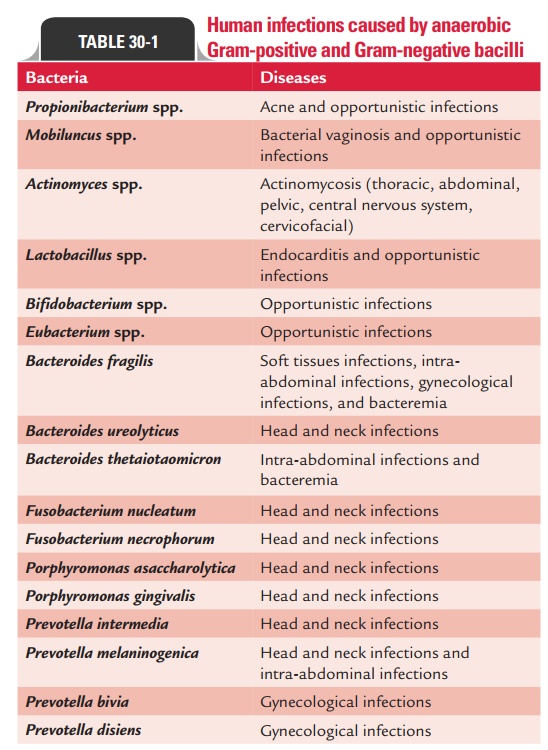Chapter: Microbiology and Immunology: Bacteriology: Nonsporing Anaerobes
Anaerobic Gram-Positive Bacilli
Anaerobic Gram-Positive Bacilli
The anaerobic non–spore-forming Gram-positive bacilli are a heterogeneous group of facultatively anaerobic or strictly anaerobic bacteria that characteristically colonize the skin and mucosal membranes. The group includes many genera, but few of these are associated with clinical infections (Table 30-1).

Propionibacterium spp., Lactobacillus spp.,Mobiluncus spp., and Actinomyces spp. are well known to cause human infections.Eubacterium spp. and Bifidobacterium spp. are isolated in clinicalspecimens; they rarely cause human disease.
◗ Propionibacterium
Propionibacterium species are anaerobic or aerotolerant bacteriafound as part of the normal flora of the skin, oropharynx, con-junctiva, external ear, and female genital tract.
· They are Gram-positive bacilli that are frequently present in short chains and clumps.
· They are nonmotile and are catalase positive.
· They ferment carbohydrates with production of propionic acid, hence named Propionibacterium.
· Propionibacterium are not fastidious. They can grow on nutri-ent agar or other simple media. However, they grow slowly, take 3–5 days to produce colonies.
Propionibacterium acnes and Propionibacterium propionicus aretwo important species of clinical importance. P. acne is the most common causative agent of acne in teenagers and young adults. The species also causes infections of heart valves or
Isolation of Propionibacterium from clinical specimens needs to be interpreted in light of the clinical condition. The lesions in acne develop within the sebaceous follicles; hence are not related to effectiveness of the cleanliness of the skin.
The condition is treated best with topical application of benzoyl peroxide and antibiotics. The bacteria are sensitive to erythromycin and clindamycin.
◗ Lactobacillus
Members of the genus Lactobacillus are facultatively anaerobic bacilli. They are commonly found in the mouth, stomach, and intestine and in the adult vagina. They are commonly isolated in blood and urine cultures. The presence of lactobacilli even in high numbers in urine culture usually represents contami-nation of bacteria from the urethra, in which lactobacillus are most commonly present. Lactobacilli usually do not cause infec-tion of the urinary tract, because they fail to grow in the urine.
Lactobacilli can invade the blood stream during (a) endocardi-tis, (b) opportunistic septicemia in immunocompromised host, and (c) transient bacteremia following genitourinary procedure.
Combined therapy with penicillin and aminoglycoside has proved effective against infections caused by lactobacilli. Lactobacilli are resistant to vancomycin.
◗ Mobiluncus
Mobiluncus species are obligate anaerobes. They are Gram-negative or Gram-variable curved bacilli with tapering ends. Despite their Gram-variable properties, they are classified as Gram-positive bacteria because they have a cell wall of Gram-positive bacilli, and they lack endotoxin. The bacteria are fas-tidious; they grow slowly on enrichment media, such as blood agar containing either rabbit or horse blood. They are found as part of the normal flora of the genitourinary tract. In women with bacterial vaginitis, they are found in very high numbers. The exact role of the bacteria as a causative of bacterial vagino-sis is not known. Typical Gram-staining features of the bacteria are diagnostic. They are sensitive to erythromycin, ampicillin, clindamycin, and vancomycin but resistant to colistin.
◗ Bifidobacterium and Eubacterium
Bifidobacterium spp. and Eubacterium spp. are commonly foundin the oropharynx, large intestine, and vagina. They are usually isolated as contaminants. Repeated isolation of these bacteria in absence of other pathogens may suggest their role as possible agents of infection.
Related Topics